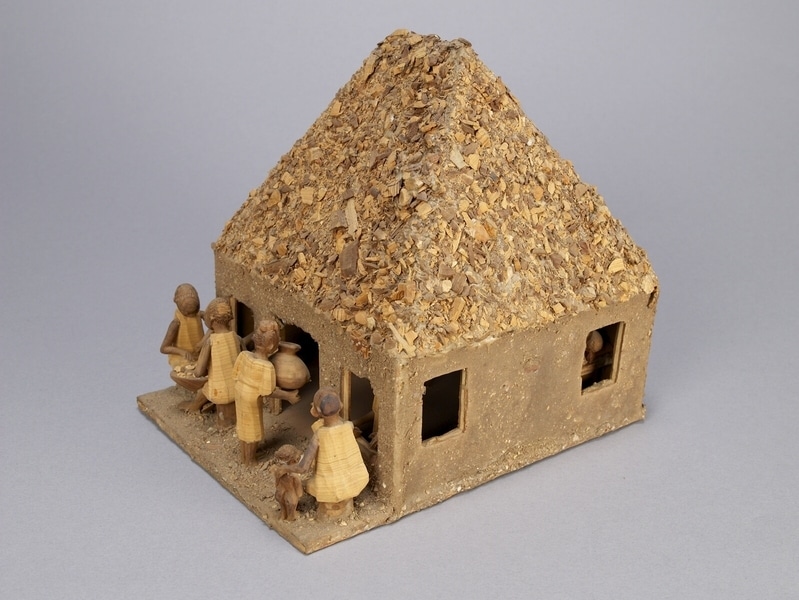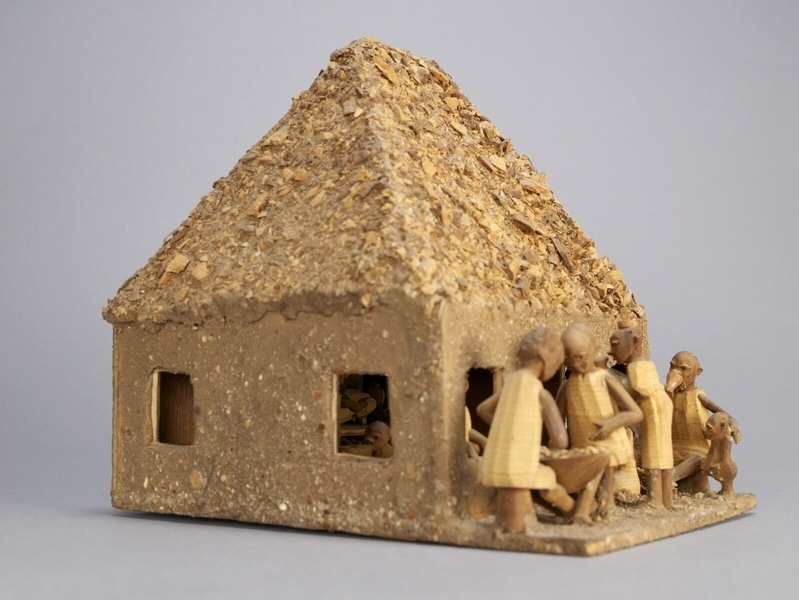Thorn Carving Item Number: Af414 from the MOA: University of British Columbia



Description
House with ten figures representing people engaged in a variety of activities. Architectural features include a four-sided peak roof covered with variegated shavings, six square windows, and an open doorway. The sides of the house and the front open area are plastered with a mud and rice glue(?) mixture with variegated chips adhering to it. The interior contains a bed with two pillows and a large pot with a pestle. Activities depicted include sleeping, food preparation, standing at windows, drinking palm wine, carrying a pot, and playing the game ayo. A naked child is sitting on the floor inside and another is standing next to a drinking figure. Sitting adults are wearing shirts and shorts while others are wearing knee-length dresses. Figure carrying pot has a coil on the head. Clothing, calabash, pot, and pestle are light yellow-brown. Human figures, carried pot, gaming board, and small pot are dark brown. Cup, pillows, and head coil are light red-brown.
History Of Use
Thorn carvings are miniatures depicting scenes from Nigerian life. This type of carving began circa 1930. Thorns are carved by men and vary in size. They can be as large as 12.7 cm long and 9.6 cm wide. They are comparatively soft and easily carved.
Cultural Context
craft; tourist art
Specific Techniques
The light yellow-brown thorn and the dark brown thorn come from the ata tree; the light red-brown thorn comes from egun trees. The parts are glued together with viscous paste made from rice cooked with water.
Narrative
This thorn carving was made specifically for the donors by the artist.
Item History
- Made in Nigeria before 1972
- Collected during 1972
- Owned by Andrew Stewart and Jessie Stewart before February 8, 1980
- Received from Andrew Stewart (Donor) and Jessie Stewart (Donor) on February 8, 1980
What
- Name
- Thorn Carving
- Identification Number
- Af414
- Type of Item
- carving
- Material
- egun thorn, rice adhesive, atum thorn and wood
- Manufacturing Technique
- carved and glued
- Overall
- height 23.3 cm, width 23.3 cm, depth 19.5 cm
Who
- Culture
- Yoruba
- Previous Owner
- Andrew Stewart and Jessie Stewart
- Received from
- Andrew Stewart (Donor) and Jessie Stewart (Donor)
Where
- Holding Institution
- MOA: University of British Columbia
- Made in
- Nigeria
When
- Creation Date
- before 1972
- Collection Date
- during 1972
- Ownership Date
- before February 8, 1980
- Acquisition Date
- on February 8, 1980
Other
- Item Classes
- carvings & sculpture
- Condition
- fair
- Accession Number
- 0590/0100